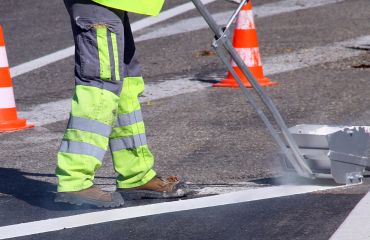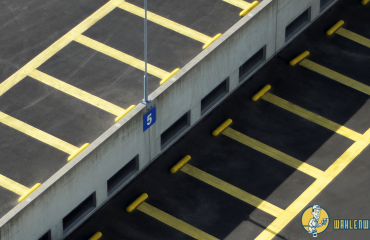
Do you realize that your pavement marking can talk? Well maybe not talk exactly, but it certainly can communicate. In fact, that is its primary function. It’s like the project manager on your team or the traffic officer at Miller Park. Fresh, high quality pavement marking keeps vehicle and pedestrian traffic organized and moving smoothly which keeps everyone safer and happier.
What Is The Purpose of Marking?
Pavement marking is so ubiquitous and so expected that most people rarely give it a thought — until it isn’t visible when they need it. If you have ever been caught in a blinding thunderstorm or found yourself with seconds to decide if you need to merge or stay put, you know that proper road surface marking is the difference between fear and confidence.
The Manual on Uniform Traffic Control Devices (MUTCD) published by the U.S. Department of Transportation says, “Pavement markings are used to convey messages to roadway users. They indicate which part of the road to use, provide information about conditions ahead, and indicate where passing is allowed.” Symbols, such as for bicycles, tell you how you are permitted to use the lanes. They can also warn you of areas where you might want to exercise caution, such as at railroad crossings.
In parking structures and on other private property, clear easy-to-understand striping tells drivers where to go and what to do. A prominent crosswalk tells pedestrians that it is safe to walk there. Signs and symbols tell both foot and vehicle traffic where they are permitted to move, wait, and park. This is good for customers and business, but it also complies with the law, specifically in regard to the Americans with Disabilities Act (ADA). When creating handicapped parking areas, a combination of clearly marked stalls and proper signage sends a warm welcome message to all visitors.
What Do Parking Lot Pavement Markings Mean?
When you enter a ramp or other parking structure, you are confronted with markings that are more complex than the standard yellow and white of the highways. Pavement marking works in conjunction with signs and (sometimes) traffic signals to direct traffic through a parking area and a yellow line (either solid or broken) is still used to indicate two-way traffic. However, you will also see stop lines, crosswalks, painted curbs, and symbol markings.
- A stop bar marking is a single white line that tells you where to stop.
- Word and symbol markings, such as yield or directional arrows, communicate to you without diverting your attention from the road.
- Crosswalk markings are parallel double white lines that tell pedestrians where they can cross the roadway. Sometimes they are accompanied by the symbol “ped xing” on the road just before the crosswalk that tells the driver to prepare to stop.
- Curb striping is used to communicate curb use rules such as no parking, fire lanes, handicapped zones, loading and unloading, parking for a short period of time, and parking allowed.
$136M Pavement Marking Project
In California, they tested a new 6-inch wide, highly reflective road striping in 2017. The $136 million project was implemented on I-80 in the capital city of Sacramento. The test was so successful that Caltrans decided to re-stripe 50,000-plus lane miles of state highway system in the next decade.
Their reasoning is that markings “must be capable of conveying information during inclement weather and evening hours when there may be little to no illumination from overhead lighting. The 6-in.-wide striping provides a valuable continuous stream of information about the roadway that signs or signals cannot supply. They alert drivers to changes in the roadway and help them maintain their position inside of the lane without requiring the driver to take their eyes off the road.”
While pavement marking obviously can’t talk, it does tell us things and communicates valuable information that we literally cannot live without. If your striping is faded or inefficient, give us a call. We’ll have it “talking” to you again in no time.


